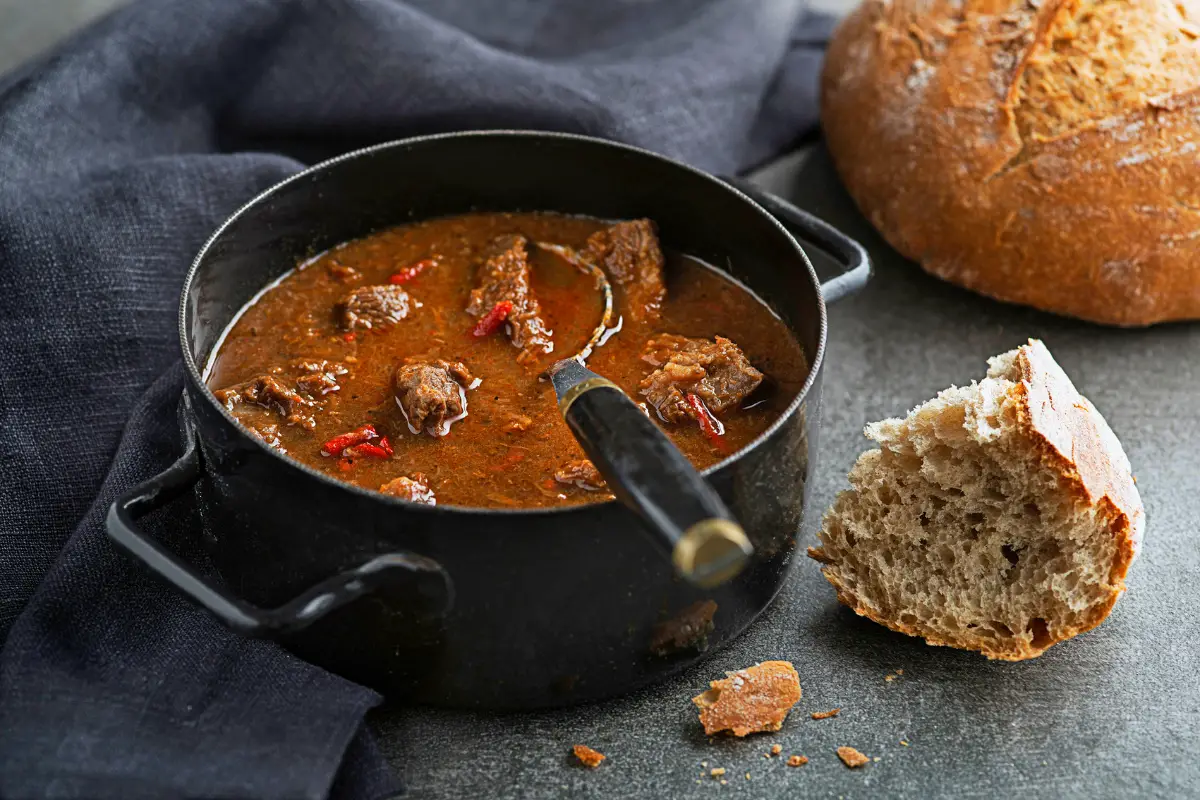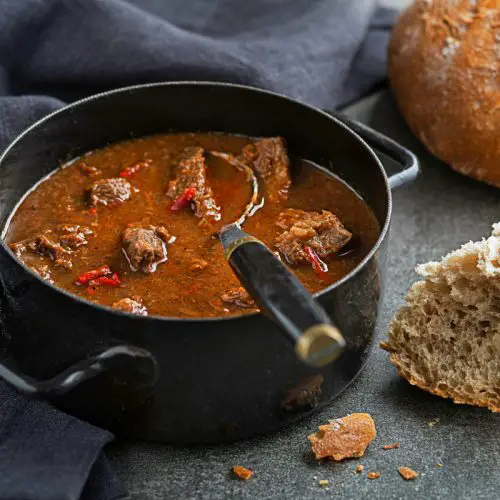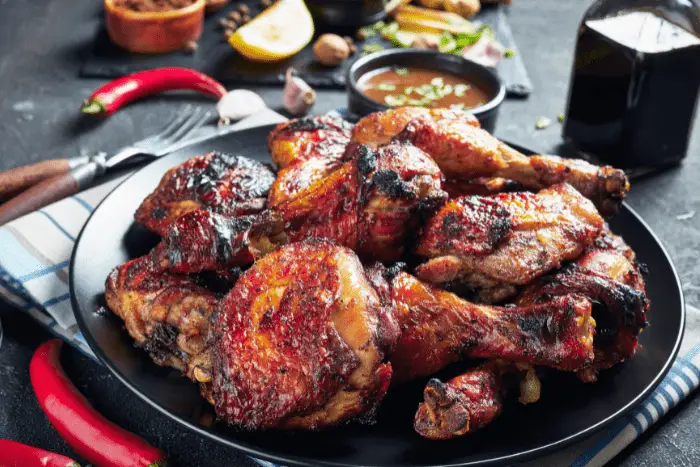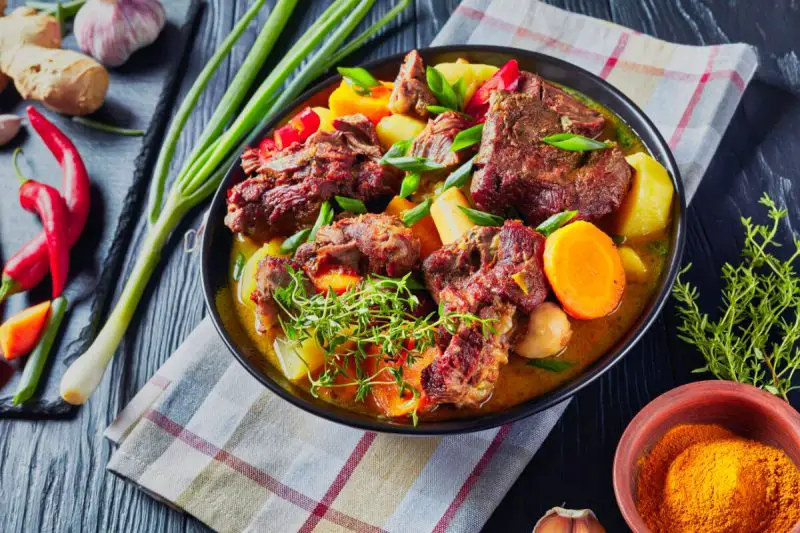
The traditional Haitian Bouyon Bef recipe, also known as Haitian Beef Stew, is a substantial and flavorful stew that highlights Haiti’s multifaceted culinary history. All around Haiti, families and communities get together to share bowls of this hearty stew. Haitian Bouyon Bef is a delicious fusion of the country’s many culinary traditions, with succulent slices of beef, an assortment of vegetables, and fragrant spices.
Want more ideas to round-out your Haitian Recipe Box?
A lot of great options are in these posts!
Bouyon Bef recipe origins may be traced back to the many cultures that have had an impact on the island nation’s culinary heritage. The meal takes inspiration from the diverse cultures that have left their mark on Haiti, including the native Tano people, African slaves, and European invaders. The meat in the stew is a holdover from the Colonial era, while the root vegetables and spices are gifts from the island’s indigenous and African communities.
You May Want to Join The World Recipes With Our Big Escape
Share your own recipes in our Facebook Group. Find recipes from all over the world. Learn more about International Cuisine and how you can surprise your family with new and exciting foods from all over the world.
For More Photos Visit Our Instagram at World Recipes Daily
The use of epis, a Haitian seasoning blend consisting of a variety of herbs, spices, and vegetables, is one of the dish’s defining characteristics. This aromatic mixture is used as the stew’s foundation, giving it a richness of taste that distinguishes it distinct from standard beef stews. The Bouyon Bef recipe and it’s use of epis, a staple of Haitian cuisine, is a reflection of the country’s dedication to honoring and conserving its culinary heritage.
The traditional Haitian Bouyon Bef recipe is reserved for more momentous occasions such as weddings, funerals, and festivals. The richness and warmth of the stew makes it a favorite choice throughout the winter months. It’s not unusual, though, to find this meal eaten at any time of year, thanks to the year-round appeal of its healthful components and pleasing tastes.
The Haitian Bouyon Bef recipe is a labor of love that requires the meat to be slow-cooked to exquisite perfection and the veggies to be added in stages to preserve the distinct textures and flavors of each ingredient. The resulting blend of flavors and textures is satisfying and comforting. Another unique aspect of the recipe is the addition of dumplings, sometimes known as “boulettes,” which offer an extra layer of heartiness and make the stew a complete and delicious meal.
Haitian Bouyon Bef is a symbol of the perseverance and ingenuity of the island country, and it also happens to be tasty. The dish is symbolic of the Haitian people’s resilience and resourcefulness because of its capacity to harmoniously combine disparate elements. By preparing and eating this meal, Haitians and foodies throughout the world may pay tribute to Haiti’s culinary heritage and celebrate the country’s colorful culture.
The Haitian meal Bouyon Bef, which is both delicious and nutritious, is representative of Haitian cuisine as a whole. The tender meat, fresh veggies, and fragrant spices in this dish provide for an uplifting and soothing taste experience. Enjoyable to eat and meaningful to share, Bouyon Bef is a mainstay of Haitian cuisine that serves as a tasty reminder of the country’s many influences and unyielding spirit.
3 Reasons People Love the Haitian Bouyon Bef Recipe
Rich, Multilayered Flavors: The complex, layered tastes that come from using a variety of spices and herbs in the Haitian Bouyon Bef recipe are a big part of why it’s so popular. Epis, a fragrant and adaptable Haitian seasoning mix, serves as the dish’s base and gives the stew its signature depth of flavor. The combination of herbs, spices, and vegetables in this mixture gives the meal its signature flavor. The slow cooking method also allows the tastes of the delicate beef, root vegetables, and spices to blend together in a way that makes for a delicious and versatile meal.
Comforting and Nourishing: The Bouyon Bef Recipe is a comforting and nourishing dish, making it a favorite choice for those seeking a satisfying and wholesome meal. The hearty combination of tender beef, vegetables, and dumplings, known as “boulettes,” provides a well-rounded, nutrient-dense meal that is both filling and delicious. This beef stew is particularly popular during colder months when its warmth and richness provide much-needed sustenance and comfort. However, its nourishing qualities also make it a beloved dish to be enjoyed year-round. The dish’s ability to warm the soul and fill the stomach makes it an enduring favorite for many who appreciate Haitian cuisine.
Connection to Haitian Culture and Heritage: Those who enjoy the Haitian Bouyon Bef recipe do so because of its delicious flavor and its association with Haitian culture and tradition. The meal incorporates elements of Tano, African, and European cuisines to pay homage to the country’s rich cultural heritage. Anyone interested in learning more about the culture and cuisine of Haiti may do so by cooking and savoring this classic dish. The communal nature of eating Bouyon Bef at celebrations, family gatherings, and community activities helps bring people together. Beyond its delicious taste, the meal is treasured for its cultural importance and its ability to bring people together.

How To Make Our Haitian Bouyon Bef Recipe
Ingredients: (8 Servings)
2 lbs beef chuck, cut into 1-inch cubes
1/4 cup epis (Haitian seasoning blend)
2 tablespoons vegetable oil
6 cups water
2 large carrots, chopped
2 large potatoes, chopped
1 large turnip, chopped
1 large onion, chopped
2 cloves garlic, minced
1/2 small cabbage, chopped
1 cup diced pumpkin
2 sprigs fresh thyme
2 whole cloves
1 Scotch bonnet pepper (whole, not cut)
Salt and pepper, to taste
1 cup all-purpose flour (for dumplings)
1/2 cup water (for dumplings)
1/2 teaspoon salt (for dumplings)
Instructions:
1. In a large bowl, mix the beef cubes with the epis, ensuring all pieces are well coated. Allow the beef to marinate for at least 30 minutes to 1 hour in the refrigerator.
2. In a large pot or Dutch oven, heat the vegetable oil over medium heat. Add the marinated beef and brown on all sides for about 5-7 minutes.
3. Add the 6 cups of water to the pot, ensuring the beef is fully covered. Bring to a boil, then reduce the heat to a simmer. Cover and cook for 1 to 1.5 hours or until the beef is tender.
4. While the beef is cooking, prepare the dumplings by mixing the flour, 1/2 cup water, and 1/2 teaspoon salt in a bowl. Knead the dough until smooth and form small dumplings by rolling the dough between your palms.
5. When the beef is tender, add the chopped vegetables, onion, garlic, thyme, cloves, and Scotch bonnet pepper to the pot. Stir gently to combine.
6. Add the dumplings to the pot, making sure they are submerged in the liquid. Cover and simmer for an additional 30-40 minutes, or until the vegetables are cooked and the dumplings are firm.
7. Adjust seasoning with salt and pepper to taste. Remove the Scotch bonnet pepper and thyme sprigs before serving.
Nutritional Information For the Haitian Bouyon Bef Recipe
Calories: 491
Carbohydrates: 37g
Protein: 34g
Fat: 23g
Saturated Fat: 9g
Cholesterol: 98mg
Sodium: 232mg
Potassium: 1146mg
Fiber: 5g
Sugar: 5g
Prep Time: 30 minutes. This includes chopping the vegetables, preparing the dumplings, and marinating the beef.
Cooking Time: 2 to 2.5 hours.
Pots, Pans, and Cooking Equipment Needed for the Haitian Bouyon Bef Recipe
Large pot or Dutch oven with lid
Large mixing bowl
Medium mixing bowl
Cutting board
Knife
Measuring cups and spoons
Wooden spoon or spatula
Best Way to Store Leftovers For the Haitian Bouyon Bef Recipe
Leftovers should be stored in an airtight container in the refrigerator. The stew will keep for up to 3-4 days. When reheating, it is best to use a stovetop, gently warming the stew over low heat to preserve the texture and flavor of the ingredients.
Possible Substitutions For the Haitian Bouyon Bef Recipe
You can substitute other root vegetables, such as yams, parsnips, or sweet potatoes, for the turnips, potatoes, or carrots.
If Scotch bonnet peppers are not available, you can use habanero peppers or another hot pepper variety, adjusting the quantity according to your heat tolerance.
Fresh thyme can be replaced with 1 teaspoon of dried thyme.
Ingredients to Substitute for a Vegetarian Version of the Haitian Bouyon Bef Recipe
Replace the beef with 2 lbs of portobello mushrooms, cut into 1-inch pieces or large cubes of firm tofu.
Use vegetable broth instead of water for a richer flavor.
Tips and Tricks for Easier Creation
To save time, you can prepare the epis in advance and store it in the refrigerator for up to 1 week or in the freezer for up to 3 months.
To ensure even cooking, cut the vegetables into similar-sized pieces.
When making the dumplings, moisten your hands with water to prevent the dough from sticking.
Possible Side Dishes and Desserts to Serve With the Haitian Bouyon Bef Recipe
White rice, brown rice, or Haitian-style rice with peas or beans
Fried plantains or boiled green plantains
A green salad with a tangy vinaigrette
For dessert, consider serving a traditional Haitian treat like pain patate (sweet potato pudding) or blancmange (coconut milk pudding).
How To Serve the Haitian Bouyon Bef Recipe
Ladle the Haitian Bouyon Bef recipe into individual serving bowls, making sure each portion includes a generous helping of beef, vegetables, and dumplings. If desired, serve the stew with a side of rice or plantains. Offer hot sauce or sliced Scotch bonnet peppers on the side for those who prefer additional heat. Enjoy the dish with friends and family, appreciating the rich flavors and cultural significance of this delicious Haitian meal.
FAQs About the Haitian Bouyon Bef Recipe
What is Haitian epis, and can I buy it pre-made?
Haitian epis is a seasoning blend made from a mixture of herbs, spices, and vegetables. It forms the base of many Haitian dishes, including Bouyon Bef. While you can make epis at home using fresh ingredients, you may also find pre-made epis in some grocery stores, particularly those specializing in Caribbean or Haitian products. Alternatively, you can search for recipes online and create your own blend using ingredients like garlic, onion, bell peppers, scallions, parsley, cilantro, thyme, and Scotch bonnet pepper.
Can I use a slow cooker or pressure cooker to make Haitian Bouyon Bef Recipe?
Yes, you can adapt the recipe to use a slow cooker or pressure cooker. For a slow cooker, follow the recipe as written, browning the beef in a separate pan before transferring it to the slow cooker. Add the vegetables, spices, and water, and cook on low for 6-8 hours or on high for 3-4 hours. Add the dumplings in the last hour of cooking. For a pressure cooker, follow the recipe steps, browning the beef directly in the pressure cooker. After adding the vegetables and water, secure the lid and cook at high pressure for 30 minutes. Release the pressure, add the dumplings, and cook for an additional 5 minutes at high pressure.
Can I freeze Haitian Bouyon Bef for later consumption?
Yes, you can freeze the stew for later use. Allow the Bouyon Bef to cool completely before transferring it to airtight containers or freezer bags. The stew can be stored in the freezer for up to 3 months. To reheat, thaw the stew in the refrigerator overnight, then warm it gently on the stovetop over low heat.
Is there a specific type of beef that works best for this recipe?
Beef chuck is the most commonly used cut for Bouyon Bef, as it becomes tender and flavorful when cooked slowly in a stew. However, you can also use other cuts of beef suitable for slow cooking, such as brisket or short ribs, with similarly delicious results.
Can I make Haitian Bouyon Bef Recipe with other meats, such as chicken or pork?
Yes, you can substitute the beef with other meats like chicken or pork. If using chicken, choose bone-in, skinless pieces for added flavor, and reduce the cooking time as needed to ensure the chicken does not become overcooked. For pork, use a cut suitable for slow cooking, such as pork shoulder or butt. Adjust the cooking time as necessary for the specific meat being used.
Final Thoughts
For many years, people all over the world have raved about the Haitian Bouyon Bef Recipe, a hearty stew distinctive of Haitian cuisine. Incorporating elements from the island’s varied cultural traditions, this delectable stew is a fitting tribute to Haiti’s numerous culinary customs. Bouyon Bef has tender beef, root vegetables, and tasty dumplings, and it is a prime example of Haitian comfort food. As a representation of the Haitian people’s resourcefulness and creativity, it has become a culinary emblem of the country.
Marinated with epis, a Haitian spice blend that serves as the cornerstone of many other cuisines, beef chuck is the main component. Beef is slow-simmered with an assortment of root vegetables and served with homemade dumplings. Vegetables including potatoes, carrots, turnips, and pumpkins are among them. The stew has an aromatic taste from the thyme and cloves, and a fiery kick from the Scotch bonnet pepper.
The Haitian Bouyon Bef Recipe is typically the featured dish during family gatherings and other celebratory occasions. Sharing a meal is highly valued in Haitian culture, and this dish’s calming flavors and smells are perfect for bringing people together for a common experience. Plantains and rice are frequent side dishes for Bouyon Bef because they complement the stew and help to absorb the flavorful sauce. If you want to experience authentic Haitian food, this dish is a must.
One of the Haitian Bouyon Bef Recipe is its versatility. The stew may be adjusted to meet the needs of those with special dietary requirements or limited access to certain ingredients. You may use chicken or pig instead of beef, and any root vegetable can be used instead. You can prepare a vegetarian version of the dish by substituting Portobello mushrooms or firm tofu for the meat.
In a world where people are more interested in consuming dishes from various nations, the Haitian Bouyon Bef Recipe stands as a symbol of the country’s rich culinary history. Those who indulge in this delicious stew will experience the fusion of flavors that have shaped Haitian cuisine throughout the centuries. Understanding, preparing, and sharing dishes like this Haitian Bouyon Bef Recipe together may help us better appreciate the world’s diverse and different culinary cultures.
In conclusion, the Haitian Bouyon Bef Recipe is more than just a hearty and flavorful stew; it is also a symbol of Haiti’s rich cultural heritage and cuisine. Its rich, savory flavors and appealing components have won the acclaim of both local Haitians and those from other countries who have had the good fortune to eat it. The versatility of the Bouyon Bef means that it may be enjoyed by those with many different types of food restrictions. While we continue to explore and appreciate the world’s diverse gourmet offerings, let us not forget the humble Bouyon Bef, a lovely reminder of Haiti’s long culinary tradition and the power of food to bring people together.
Haitian Bouyon Bef
Equipment
- Large pot or Dutch oven with lid
- Large mixing bowl
- Medium mixing bowl
- Cutting board
- knife
- Measuring cups and spoons
- Wooden spoon or spatula
Ingredients
- 2 lbs beef chuck, cut into 1-inch cubes
- 1/4 cup epis (Haitian seasoning blend)
- 2 tbsp vegetable oil
- 6 cups water
- 2 large carrots, chopped
- 2 large potatoes, chopped
- 1 large turnips, chopped
- 1 large onions, chopped
- 2 cloves garlic, minced
- 1/2 small cabbage, chopped
- 1 cup diced pumpkin
- 2 sprigs fresh thyme
- 1 1 Scotch bonnet pepper (whole, not cut)
- 1 cup all-purpose flour (for dumplings)
- 1/2 cup cup water (for dumplings)
- 1/2 tsp teaspoon salt (for dumplings)
- Salt and pepper, to taste
Instructions
- In a large bowl, mix the beef cubes with the epis, ensuring all pieces are well coated. Allow the beef to marinate for at least 30 minutes to 1 hour in the refrigerator.
- In a large pot or Dutch oven, heat the vegetable oil over medium heat. Add the marinated beef and brown on all sides for about 5-7 minutes.
- Add the 6 cups of water to the pot, ensuring the beef is fully covered. Bring to a boil, then reduce the heat to a simmer. Cover and cook for 1 to 1.5 hours or until the beef is tender.
- While the beef is cooking, prepare the dumplings by mixing the flour, 1/2 cup water, and 1/2 teaspoon salt in a bowl. Knead the dough until smooth and form small dumplings by rolling the dough between your palms.
- When the beef is tender, add the chopped vegetables, onion, garlic, thyme, cloves, and Scotch bonnet pepper to the pot. Stir gently to combine.
- Add the dumplings to the pot, making sure they are submerged in the liquid. Cover and simmer for an additional 30-40 minutes, or until the vegetables are cooked and the dumplings are firm.
- Adjust seasoning with salt and pepper to taste. Remove the Scotch bonnet pepper and thyme sprigs before serving.


